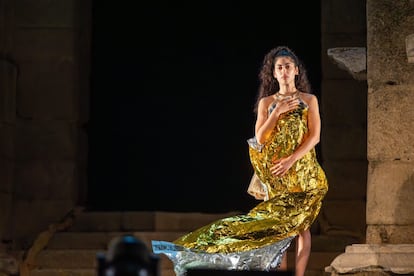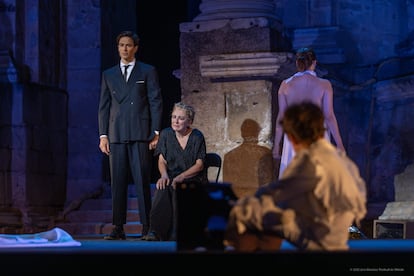In the stands of the Roman theater of Mérida the fans fight their own battle. Thousands of people wiggle their gadget trying to cool off on a night of overwhelming heat. On the tables, on the other hand, the war is already lost. The great Troy has fallen and its women, stripped of wealth and family, wait in a raffle. Is the story of The TrojansEuripides’ famous text that Carlota Ferrer premiered on Wednesday at the Mérida Classic Theater Festival, with a free and contemporary version starring Isabel Ordaz, with whom Ferrer also signs the text, and Mina El Hammani. The optical noise of the fans will soon be buried by a visual stimuli bite that will parade through the scene with the intention of providing contemporary meaning to the millenary text.
It is not the first time that the eternal classic of Euripides Pisa the Emeritense scenario, nor the first time that he submits to a reading with fully contemporary languages. In 2017 – the closest antecedent within the festival – Carme Portaceli offered a version that moved the action to the Syrian War, recreating on the tables the devastated city of Aleppo and populating the scenario of corpses wrapped in white blankets. Carlota Ferrer’s new assembly avoids any parallelism so explicit with current conflicts, but it is inevitable – as the creative team admits – to think about the Gaza Strip. The tragedy of the Trojans, women who, after the fall of their city and the death of husbands, children and grandchildren, were at the mercy of the victors to be raffled, tortured, raped and enslaved, is the story of all the defeated: that of truncated childhood, the forced exodus, the nonsense of the war that is stripped of epic to show its crudeness. And in the times that are run – how many years he has been repeating the phrase – it becomes special sense. The multifaceted Ferrer – also responsible for the scenery and costumes – involves the work in a visual and sound language today, but preserves intact the marrow of a text that, more than 2,500 years later, continues to question the present. “We were looking for testimonies of both Ukraine and Gaza to see how women talked to the camera and told what was happening, and I realized that it was very similar to what Euripides already said,” said the director minutes after the premiere.
The show opens with a prologue without text in which the characters, dressed as Trojan classics, seem to emerge from a relief that captures a moment of the battle of Troy. Everything is movements and sounds, a kind of brief dance that, without blows or fighting, reconstructs the contest. But that is the only moment when Mérida rises classic and archetypal Trojans; From there, Ferrer displays his characteristic arsenal of visual and sound resources: projections, music, sound effects, dance, and even the presentation of a character singing, microphone in hand, which rock star, sometimes everything simultaneously. An audiovisual poetic exercise, “weird things that arise from intuition,” she says, who challenges the viewer and intends to “add and impregnate in the skin”, without diverting the attention of the text.
The truth is that it is a job that enters, above all, through the eyes, and it is in its visual constructions that a contemporary reading finds. There is no more scenography than the imposing curtain of Roman columns in the background flanked by two tents to the sides that serve and exit from the characters. They are the actors who, through diverse choreographies, fill the enormous space during the scenes. The Trojan choir is reduced to a small group of faceless women or voice and with a number behind the back, reminiscent of modern prisoners; Greek soldiers wear camouflage clothes and balaclavas; And Taltibio, the Greek herald who carries an arsenal of Funestas news during the work, is a clumsy diplomatic suit.

The main challenge, explains the director, was to make “of this a montage where there were humans and not archetypal characters.” That is why the actors also detach themselves from the grandiosity and declamation of the classic text and present interpretations sometimes more contained and taken to the ground, although all this implies “the risk that the theater stones will eat you”. The rhythm and tone of the work is implemented by Isabel Ordaz, who plays Queen Hécuba and almost does not leave the stage during the little more than 90 minutes of representation. Ordaz evokes with his character a grandmother or mother or mother -in -law today, but who, with explosive moments, is still the powerful Trojan queen of antiquity. The absence of choir in this version gives Hécuba, which says many of his texts, an additional prominence.
Mina El Hammani, although the function is well entrusted to the stage, interprets the important role of Helena, Menelao’s wife and indirect cause of the Trojan War. The rest of the cast is completed by Cristobal Suárez in the role of Taltibio; María Vázquez as Casandra; Esther Ortega as Andromaca; Abel de la Fuente as Astianacte, son of Andromaca – and the son of Ortega too; Carlos Beluga as Menelao, the King of Sparta. All, in addition to incarnating their characters, go up to the scene with constancy to fill the space with choreographies while representing soldiers or Trojans. They also provide movement, without specific characters, Selam Ortega, Ana Erdozain and Alba González.
When the show approaches its end, the heat does not yield, but the fans no longer dance so much. The space that Hécuba lived for about two hours, suddenly becomes a beach full of tourists who vacation cheerful. There are no Trojans, no Trojans, or ruins, only the inert and lifeless body of that woman who was once queen and who now camouflages among the bathers. “Exodus,” reads a projection in the columns. Nor is the memory of what was once. Summarized in a scene the validity of the work, the silence breaks the applause.

